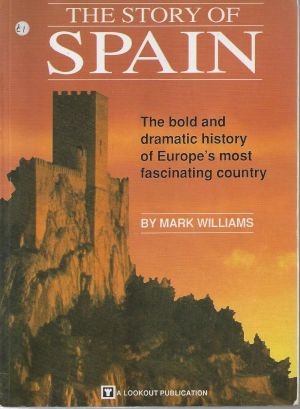
The Story of Spain by Mark Williams |
|
The Story of Spain by Mark Williams
Mark Williams takes the reader through the history of Spain in a descriptive way, unravelling the history of what he portrays to be “Europe’s most fascinating country”. The first page introduces us to the Romans in Spain and traces the reader through important topics such as Medieval Spain, Moorish Spain, the Spanish War and the Age of Franco. For an interesting and insightful look into what really makes ‘The Story of Spain’, Williams’ book is worth a read.
The following is an excerpt from the book, which introduces the chapter on ‘Liberal Spain’
Liberal Spain
Hanging in Madrid’s Prado Museum are two of Goya’s most powerful canvases, titled simply “The Second of May” and “The Third of May”. Together they depict the most important 48 hours in Spanish history, the virtual birth of modern Spain. For the story of Spain and its empire, the year 1808 is the closest in importance to 1492. Events shook centuries of ingrained attitudes, astounded a continent on the verge of collapse before Napoleon, and set ablaze the whole of Spanish America.
On May 2, 1808, a Madrid mob rose with incredible fury against the French army and its Mameluke cavalry. Men and women from the poor neighbourhoods grabbed any weapon they could find – knives, shovels, sticks, axes – and descended on the intruders. Balconies and windows vomited a shower of tiles, bricks, stones, boiling water, wash-tubs and furniture. In “Dos de Mayo” Goya painted knife-wielding women pulling the terrified Mamelukes from their horses. Dozens of these Egyptian mercenaries were bludgeoned to death before French regulars regained control. Throughout the uproar wealthy Madrileños locked their doors, and the Spanish garrison stayed meekly in its quarters. This was a new type of popular street-rising that would come again.
Those suspected of the massacre were rounded up and executed the following day, a scene Goya witnessed from a nearby window while he sketched feverishly. More than its companion oil, the painting “Tres de Mayo” is considered a landmark of modern art, both in its impassioned theme and innovative technique. Goya captured all the emotion of the scene – the ominous firing squad, the terrified but defiant victims with their outstretched arms, the blood-drenched corpses rapidly filling the square. He also preserved for eternity those few frenzied moments that marked the start of Spain’s War of Independence (what we know as the Peninsular War).
Goya himself viewed that war with the same mixed emotions felt by so many Spaniards. As any good patriot he detested the invader, but he greatly admired French accomplishments championed by Napoleon, which seemed to herald a new world capable of replacing Spain’s inert society. In the end Goya came to detest war regardless of its outcome; his series of searing etchings, “Disasters of War” (also in the Prado), contain no marching armies or glorious deeds, only the horror and destruction of warfare. To Goya we owe our visual perceptions of these frightful times. His macabre vision took Spanish realism into realms never imagined by Velasquez or Ribera.
To follow the rest of the story of Spain as told by Mark Williams, buy from Amazon, click on the link below.
Buy your copy of The Story of Spain by Mark Williams
Mark Williams takes the reader through the history of Spain in a descriptive way, unravelling the history of what he portrays to be Europe most fascinating country. The first page introduces us to the Romans in Spain and traces the reader through important topics such as Medieval Spain, Moorish Spain, the Spanish War and the Age of Franco.
Buy from Amazon.co.uk or Amazon.es
 The Story of Spain by Mark Williams
The Story of Spain by Mark Williams